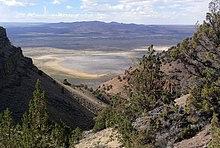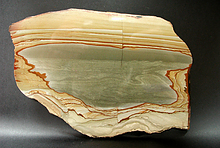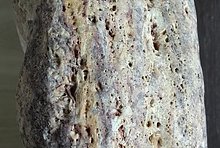A Scientific Study of the Absorption of Evil by Vivianite
Last Updated: 14th Sep 2020By Alfredo Petrov
by Alfredo Petrov, 2006
Every mineral collector has at one time or another probably drooled over a gemmy green vivianite from Morococala, Huanuni, Llallagua or Tomokoni in Bolivia, or Trepca in Serbia, or the Blackbird mines in Idaho, but hesitated to buy it because they had heard that vivianite crystals are unstable and will eventually turn black and fall apart, especially when exposed to bright light; or perhaps they went ahead and purchased a fine crystal anyway because some reputable high-end dealer (undoubtedly a highly successful used car salesman in a previous life) assured them that this particular extremely fine and important specimen came from a locality which produces "stable" vivianite – stable because of some magical ingredient in the matrix, or absence of something in the matrix, or lack of oxygen at the high elevations the crystal grew in, or lack of bacteria at the high elevation….. You get the picture. Or perhaps the dealer convinced the customer that he wouldn’t have a problem with vivianites because he lived in a sufficiently dry region (or a sufficiently humid one), or at a high Rocky Mountain altitude with low atmospheric oxygen….
All of this nonsense comes from statements I personally heard while wandering around mineral shows, or read in dealer advertizing; I promise I didn’t make any of them up. Unfortunately, the bad news is that ALL vivianite suffers from the same type of instability; the good news is that its decomposition can be easily prevented. But before we discuss how to preserve vivianite specimens we need to understand the chemical mechanism involved in its self-destruction.
My favorite explanation for the instability of vivianite came from a couple of lovable young mystical counterculture types I met at the Tucson gem and mineral show. They had bought several bolivian vivianites from me at Tucson 2003 and came back for more in 2004. “The last ones we got turned black already”, they told me with a happy - even gleeful - expression. “Did you leave them in a sunny window?”, I asked, “You mustn’t expose them to bright light”. Turns out they wanted their vivianites to turn black and were delighted when the hoped-for phenomenon really happened. Apparently, vivianite gradually gets darker and darker by absorbing “evil energies” from its surroundings. After it gets black one has to throw it away and go buy a fresh one. I hadn’t known this before but, as an occasional exporter of bolivian vivianite, I thought it was a wonderful discovery! This unexpected and valuable property of vivianite will surely expand the market for it, and Bolivia will finally have a near monopoly on a natural resource the rest of the world will be standing in line to buy (especially considering the amount of evil our current administration has discovered lurking in evolutionary biology textbooks, sex education classes, the Iranian government, embryonic stem cell labs, gay weddings ….).
Probably not a whole lot of mystics read my articles, so I sort of feel an obligation to come up with an explanation that involves more physical chemistry and fewer supernatural powers: The vivianite molecule is a phosphate of divalent iron, with a lot of water: Fe2+3(PO4)2(H2O)8. It crystallizes in several types of environment, and we ought to describe these before we get into the crystal chemistry:
One environment is mud and other low-oxygen sedimentary rocks, usually in the reducing environment associated with fossil organic matter – Such localities include the world’s largest vivianite crystals (more than a meter long) from mud in Cameroon, the aesthetic crystal sprays in fossil shells from the Kerch peninsula on the Black Sea, the concretions from lake bed and seafloor muds at several localities in Japan, and those from various U.S. localities including Florida, New Jersey, and Contra Costa county, California. Bones and teeth buried in peat bogs are sometimes replaced by vivianite.
Another type of environment is hydrothermal sulphide ore veins, including all the localities already mentioned in the first paragraph above, along with the Ashio mine in Japan, and other mines in Peru, Cornwall, Colorado and elsewhere. It is this latter environment, the hydrothermal veins, that produces the most splendid crystal specimens with the classic gemmy green colour. While on the subject of hydrothermal ore vein vivianite, we should kill another myth that occasionally shows up in print (eg: Bideaux, et al., in the Handbook of Mineralogy): Yes, a lot of colourful phosphates may be characteristic of the oxide zone of ore deposits, but vivianite is not one of them! You hardly ever find it in limonitic vugs in gossan. (I'm tempted to say "never", but I know someone will then come up with an exception!) It occurs associated with siderite and unoxidized pyrite and other sulphides in deep unoxidized levels of ore deposits; if your specimen appears to be sitting on limonite, check more carefully – the “limonite” will generally turn out to be hisingerite or some other brown iron silicate or phosphate.
Phosphate-rich pegmatites, like the ones in the Black Hills (South Dakota), provide another, although relatively minor, source of vivianite, most recently some fairly large crystals perched on muscovite from Brazil. Other vivianite environments, of no importance to collectors, include rocks altered by coal mine fires, and smelter slags.
The late Dr. Fred Pough observed that sedimentary vivianite changed colour and flaked apart faster than hydrothermal vivianite. I haven’t studied this in a controlled experiment, but subjectively I tend to agree with him. If this is indeed true, the increased instability may be caused by other elements substituting for Fe or P in the crystal lattice. Sedimentary vivianite from lake bed muds, for instance, can contain several weight percent manganese substituting for iron, whereas hydrothermal vivianites (at least those from the Siglo XX and Ashio mines) contain only negligible traces of Mn and Mg replacing Fe.
Now let’s look at the self-destruction mechanism: Some people think vivianite darkens by oxidation – absorbing oxygen from the atmosphere – and then flakes apart along the cleavages by “drying out”, i.e. losing some of its 8 waters. They optimistically hope that both of these processes can be hindered by a thin coating of lacquer (which is why some specimens in old collections were varnished), or by dipping in oil, or sealing it in a glass jar. They are correct that both oxidation and water loss are taking place, but not in the way they imagine and not in any way that could be prevented by a coating of lacquer no matter how thick! To somewhat oversimplify and paraphrase the process, when photons (particles of light energy) enter a transparent vivianite crystal, they can knock a proton (a hydrogen nucleus) out of one of the 8 water molecules, which converts the water into a hydroxyl ion (OH) which has a negative charge. This extra negative charge is balanced by oxidation of one iron atom, whose valence state changes from 2+ (ferrous) to 3+ (ferric). Notice that no interaction with the atmosphere was involved – No oxygen entered the structure from outside, and no water molecule escaped to the outside; we are dealing with a completely internal reaction (oxidation by deprotonation). The liberated hydrogen (the proton) easily migrates through the crystal lattice, as in other species of proton-conducting crystals (which are currently undergoing intense study for potential industrial uses like fuel cells). No coat of lacquer is going to prevent this.
The end result is that the vivianite changes into another mineral species, metavivianite (also known as "kertschenite"), Fe2+2Fe3+(PO4)2(OH)(H2O)7. This alteration is accompanied by a progressive colour change. Absolutely pure fresh end-member vivianite is colourless! A minor amount of light-induced oxidation rapidly changes the colour to a brilliant transparent green – We are talking here in terms of a few minutes rather than weeks or years. Further oxidation changes the colour to a deeper emerald green and a strong pleochroism sets in, with the colour in transmitted light becoming a cobalt blue when the crystal is rotated to a certain angle. The mystical crowd gets quite excited by this “blue flash” and believe such vivianite crystals to be special; it is, alas, just one stage on the timeline to self-destruction. Eventually the whole crystal turns an opaque deep blue and finally bluish black. As a historical aside, powdered vivianite used to be used in blue oil paint, with the blue colour becoming more intense as time went on, as opposed to powdered azurite paint which tends to slowly alter into malachite, resulting in the greenish skies of some old paintings.
Theoretically, if another proton gets knocked out of the molecule, we get the mineral ferrostrunzite, Fe2+Fe3+2(PO4)2(OH)2(H2O)6, but this does not happen as easily as the change from vivianite to metavivianite. The reason is that the iron in vivianite actually occupies two different types of sites (the formula as usually written is oversimplified and doesn’t reflect the structure very well), and one of these structural sites is easier to oxidize than the other. By the time metavivianite is formed, most of the more easily oxidized Fe has already been used up.
Knocking out yet one more proton would leave us with Fe3+3(PO4)2(OH)3(H2O)5, which corresponds to the species ferristrunzite and santabarbaraite. No further reaction can take place because at this point there is no more divalent iron left to oxidize. Since santabarbaraite occurs as pseudomorphs after vivianite, it would seem that these reactions really do happen in nature, although light may not play a role in these later stages.
A similar oxidation process also happens to paravauxite, Fe2+Al2(PO4)2(OH)2(H2O)8, which alters to sigloite, Fe3+Al2(PO4)2(OH)3(H2O)7, after a few hours in close proximity to an incandescent light bulb; perhaps heat is the culprit here rather than light. Some other species of hydrous ferrous phosphates, for example ludlamite and vauxite, seem to be stable and remain unaffected under these conditions, in spite of their chemical similarity to vivianite and paravauxite.
Another factor that remains to be tested is which wavelengths of light are responsible for the reaction in vivianite. Many people assume that blue and ultraviolet light, the more energetic wavelengths, must be responsible, but this is not necessarily the case and I have a hunch that yellow, red or infrared might be responsible. (In the case of another light-sensitive mineral, realgar, it has already been determined that green light is the violent destructive agent, not blue or ultraviolet.)
The practical application of these theories is that we can suggest two alternative courses of action for preserving the transparency and color of pristine vivianite crystals:
1) Keep them in the dark. That doesn’t mean “shade”; it means in a closed cotton-lined box in a drawer, not in a glass case. Let the great unwashed public ooh and aah over your green tourmaline, emerald and forsterite; they don’t need to see your vivianites. Reserve the vivianite for short-term viewing by your connoisseur friends – A few minutes exposure indoors once in a while isn’t going to noticeably hurt it.
2) Keep all evil out of the house. Meditate. Burn incense. Avoid nasty thoughts about your ex-spouse and mother-in-law. Don’t be jealous of your neighbour’s new boat. Before your next cocktail party, remove from your guest list any drug dealers, terrorists, politicians and lawyers.
Personally, I think the first method is more likely to be effective.
(A previous version of this article was published in the October 2006 issue of Mineral News.)
Every mineral collector has at one time or another probably drooled over a gemmy green vivianite from Morococala, Huanuni, Llallagua or Tomokoni in Bolivia, or Trepca in Serbia, or the Blackbird mines in Idaho, but hesitated to buy it because they had heard that vivianite crystals are unstable and will eventually turn black and fall apart, especially when exposed to bright light; or perhaps they went ahead and purchased a fine crystal anyway because some reputable high-end dealer (undoubtedly a highly successful used car salesman in a previous life) assured them that this particular extremely fine and important specimen came from a locality which produces "stable" vivianite – stable because of some magical ingredient in the matrix, or absence of something in the matrix, or lack of oxygen at the high elevations the crystal grew in, or lack of bacteria at the high elevation….. You get the picture. Or perhaps the dealer convinced the customer that he wouldn’t have a problem with vivianites because he lived in a sufficiently dry region (or a sufficiently humid one), or at a high Rocky Mountain altitude with low atmospheric oxygen….
All of this nonsense comes from statements I personally heard while wandering around mineral shows, or read in dealer advertizing; I promise I didn’t make any of them up. Unfortunately, the bad news is that ALL vivianite suffers from the same type of instability; the good news is that its decomposition can be easily prevented. But before we discuss how to preserve vivianite specimens we need to understand the chemical mechanism involved in its self-destruction.
My favorite explanation for the instability of vivianite came from a couple of lovable young mystical counterculture types I met at the Tucson gem and mineral show. They had bought several bolivian vivianites from me at Tucson 2003 and came back for more in 2004. “The last ones we got turned black already”, they told me with a happy - even gleeful - expression. “Did you leave them in a sunny window?”, I asked, “You mustn’t expose them to bright light”. Turns out they wanted their vivianites to turn black and were delighted when the hoped-for phenomenon really happened. Apparently, vivianite gradually gets darker and darker by absorbing “evil energies” from its surroundings. After it gets black one has to throw it away and go buy a fresh one. I hadn’t known this before but, as an occasional exporter of bolivian vivianite, I thought it was a wonderful discovery! This unexpected and valuable property of vivianite will surely expand the market for it, and Bolivia will finally have a near monopoly on a natural resource the rest of the world will be standing in line to buy (especially considering the amount of evil our current administration has discovered lurking in evolutionary biology textbooks, sex education classes, the Iranian government, embryonic stem cell labs, gay weddings ….).
Probably not a whole lot of mystics read my articles, so I sort of feel an obligation to come up with an explanation that involves more physical chemistry and fewer supernatural powers: The vivianite molecule is a phosphate of divalent iron, with a lot of water: Fe2+3(PO4)2(H2O)8. It crystallizes in several types of environment, and we ought to describe these before we get into the crystal chemistry:
One environment is mud and other low-oxygen sedimentary rocks, usually in the reducing environment associated with fossil organic matter – Such localities include the world’s largest vivianite crystals (more than a meter long) from mud in Cameroon, the aesthetic crystal sprays in fossil shells from the Kerch peninsula on the Black Sea, the concretions from lake bed and seafloor muds at several localities in Japan, and those from various U.S. localities including Florida, New Jersey, and Contra Costa county, California. Bones and teeth buried in peat bogs are sometimes replaced by vivianite.
Another type of environment is hydrothermal sulphide ore veins, including all the localities already mentioned in the first paragraph above, along with the Ashio mine in Japan, and other mines in Peru, Cornwall, Colorado and elsewhere. It is this latter environment, the hydrothermal veins, that produces the most splendid crystal specimens with the classic gemmy green colour. While on the subject of hydrothermal ore vein vivianite, we should kill another myth that occasionally shows up in print (eg: Bideaux, et al., in the Handbook of Mineralogy): Yes, a lot of colourful phosphates may be characteristic of the oxide zone of ore deposits, but vivianite is not one of them! You hardly ever find it in limonitic vugs in gossan. (I'm tempted to say "never", but I know someone will then come up with an exception!) It occurs associated with siderite and unoxidized pyrite and other sulphides in deep unoxidized levels of ore deposits; if your specimen appears to be sitting on limonite, check more carefully – the “limonite” will generally turn out to be hisingerite or some other brown iron silicate or phosphate.
Phosphate-rich pegmatites, like the ones in the Black Hills (South Dakota), provide another, although relatively minor, source of vivianite, most recently some fairly large crystals perched on muscovite from Brazil. Other vivianite environments, of no importance to collectors, include rocks altered by coal mine fires, and smelter slags.
The late Dr. Fred Pough observed that sedimentary vivianite changed colour and flaked apart faster than hydrothermal vivianite. I haven’t studied this in a controlled experiment, but subjectively I tend to agree with him. If this is indeed true, the increased instability may be caused by other elements substituting for Fe or P in the crystal lattice. Sedimentary vivianite from lake bed muds, for instance, can contain several weight percent manganese substituting for iron, whereas hydrothermal vivianites (at least those from the Siglo XX and Ashio mines) contain only negligible traces of Mn and Mg replacing Fe.
Now let’s look at the self-destruction mechanism: Some people think vivianite darkens by oxidation – absorbing oxygen from the atmosphere – and then flakes apart along the cleavages by “drying out”, i.e. losing some of its 8 waters. They optimistically hope that both of these processes can be hindered by a thin coating of lacquer (which is why some specimens in old collections were varnished), or by dipping in oil, or sealing it in a glass jar. They are correct that both oxidation and water loss are taking place, but not in the way they imagine and not in any way that could be prevented by a coating of lacquer no matter how thick! To somewhat oversimplify and paraphrase the process, when photons (particles of light energy) enter a transparent vivianite crystal, they can knock a proton (a hydrogen nucleus) out of one of the 8 water molecules, which converts the water into a hydroxyl ion (OH) which has a negative charge. This extra negative charge is balanced by oxidation of one iron atom, whose valence state changes from 2+ (ferrous) to 3+ (ferric). Notice that no interaction with the atmosphere was involved – No oxygen entered the structure from outside, and no water molecule escaped to the outside; we are dealing with a completely internal reaction (oxidation by deprotonation). The liberated hydrogen (the proton) easily migrates through the crystal lattice, as in other species of proton-conducting crystals (which are currently undergoing intense study for potential industrial uses like fuel cells). No coat of lacquer is going to prevent this.
The end result is that the vivianite changes into another mineral species, metavivianite (also known as "kertschenite"), Fe2+2Fe3+(PO4)2(OH)(H2O)7. This alteration is accompanied by a progressive colour change. Absolutely pure fresh end-member vivianite is colourless! A minor amount of light-induced oxidation rapidly changes the colour to a brilliant transparent green – We are talking here in terms of a few minutes rather than weeks or years. Further oxidation changes the colour to a deeper emerald green and a strong pleochroism sets in, with the colour in transmitted light becoming a cobalt blue when the crystal is rotated to a certain angle. The mystical crowd gets quite excited by this “blue flash” and believe such vivianite crystals to be special; it is, alas, just one stage on the timeline to self-destruction. Eventually the whole crystal turns an opaque deep blue and finally bluish black. As a historical aside, powdered vivianite used to be used in blue oil paint, with the blue colour becoming more intense as time went on, as opposed to powdered azurite paint which tends to slowly alter into malachite, resulting in the greenish skies of some old paintings.
Theoretically, if another proton gets knocked out of the molecule, we get the mineral ferrostrunzite, Fe2+Fe3+2(PO4)2(OH)2(H2O)6, but this does not happen as easily as the change from vivianite to metavivianite. The reason is that the iron in vivianite actually occupies two different types of sites (the formula as usually written is oversimplified and doesn’t reflect the structure very well), and one of these structural sites is easier to oxidize than the other. By the time metavivianite is formed, most of the more easily oxidized Fe has already been used up.
Knocking out yet one more proton would leave us with Fe3+3(PO4)2(OH)3(H2O)5, which corresponds to the species ferristrunzite and santabarbaraite. No further reaction can take place because at this point there is no more divalent iron left to oxidize. Since santabarbaraite occurs as pseudomorphs after vivianite, it would seem that these reactions really do happen in nature, although light may not play a role in these later stages.
A similar oxidation process also happens to paravauxite, Fe2+Al2(PO4)2(OH)2(H2O)8, which alters to sigloite, Fe3+Al2(PO4)2(OH)3(H2O)7, after a few hours in close proximity to an incandescent light bulb; perhaps heat is the culprit here rather than light. Some other species of hydrous ferrous phosphates, for example ludlamite and vauxite, seem to be stable and remain unaffected under these conditions, in spite of their chemical similarity to vivianite and paravauxite.
Another factor that remains to be tested is which wavelengths of light are responsible for the reaction in vivianite. Many people assume that blue and ultraviolet light, the more energetic wavelengths, must be responsible, but this is not necessarily the case and I have a hunch that yellow, red or infrared might be responsible. (In the case of another light-sensitive mineral, realgar, it has already been determined that green light is the violent destructive agent, not blue or ultraviolet.)
The practical application of these theories is that we can suggest two alternative courses of action for preserving the transparency and color of pristine vivianite crystals:
1) Keep them in the dark. That doesn’t mean “shade”; it means in a closed cotton-lined box in a drawer, not in a glass case. Let the great unwashed public ooh and aah over your green tourmaline, emerald and forsterite; they don’t need to see your vivianites. Reserve the vivianite for short-term viewing by your connoisseur friends – A few minutes exposure indoors once in a while isn’t going to noticeably hurt it.
2) Keep all evil out of the house. Meditate. Burn incense. Avoid nasty thoughts about your ex-spouse and mother-in-law. Don’t be jealous of your neighbour’s new boat. Before your next cocktail party, remove from your guest list any drug dealers, terrorists, politicians and lawyers.
Personally, I think the first method is more likely to be effective.
(A previous version of this article was published in the October 2006 issue of Mineral News.)
Article has been viewed at least 37065 times.

















Tomokoni mine, Canutillos subdistrict, Cornelio Saavedra Province, Potosí, Bolivia